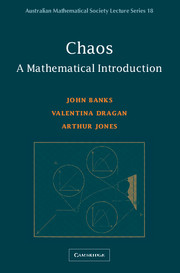Book contents
- Frontmatter
- Contents
- Preface
- 1 Making predictions
- 2 Mappings and orbits
- 3 Periodic orbits
- 4 Asymptotic orbits I: linear and affine mappings
- 5 Asymptotic orbits II: differentiable mappings
- 6 Families of mappings and bifurcations
- 7 Graphical composition, wiggly iterates and zeroes
- 8 Sensitive dependence
- 9 Ingredients of chaos
- 10 Schwarzian derivatives and ‘woggles’
- 11 Changing coordinates
- 12 Conjugacy
- 13 Wiggly iterates, Cantor sets and chaos
- Index
13 - Wiggly iterates, Cantor sets and chaos
Published online by Cambridge University Press: 05 June 2012
- Frontmatter
- Contents
- Preface
- 1 Making predictions
- 2 Mappings and orbits
- 3 Periodic orbits
- 4 Asymptotic orbits I: linear and affine mappings
- 5 Asymptotic orbits II: differentiable mappings
- 6 Families of mappings and bifurcations
- 7 Graphical composition, wiggly iterates and zeroes
- 8 Sensitive dependence
- 9 Ingredients of chaos
- 10 Schwarzian derivatives and ‘woggles’
- 11 Changing coordinates
- 12 Conjugacy
- 13 Wiggly iterates, Cantor sets and chaos
- Index
Summary
Our study of chaos so far has been restricted to ‘chaos on the interval [0, 1]’; that is, to the chaotic behaviour of functions which map the closed interval [0, 1] onto itself. We have ignored what happens to other types of mappings, such as those in the tent and logistic families for parameter values µ > 4.
Although these mappings do not map the interval [0, 1] into itself, there are many subsets of [0, 1] which they do map into themselves. Such sets are called invariant sets for the mapping. We show that each mapping, in a certain class, has a largest invariant set, which we denote by C.
To study the dynamics of the mapping on C, we use the concept of ‘wiggly iterates’, which enables us to develop the theory in close analogy with that developed earlier for mappings from [0, 1] onto [0, 1].
There are two cases which can occur:
(i) f has wiggly iterates and the invariant set is an esoteric type of set known as a Cantor set. We can show in this case that the mapping, when restricted to the Cantor set, has chaotic behaviour in the sense of Devaney.
(ii) f does not have wiggly iterates. The invariant set is not a Cantor set and the behaviour of the mapping will not usually be chaotic on the invariant set.
- Type
- Chapter
- Information
- Chaos: A Mathematical Introduction , pp. 255 - 286Publisher: Cambridge University PressPrint publication year: 2003

